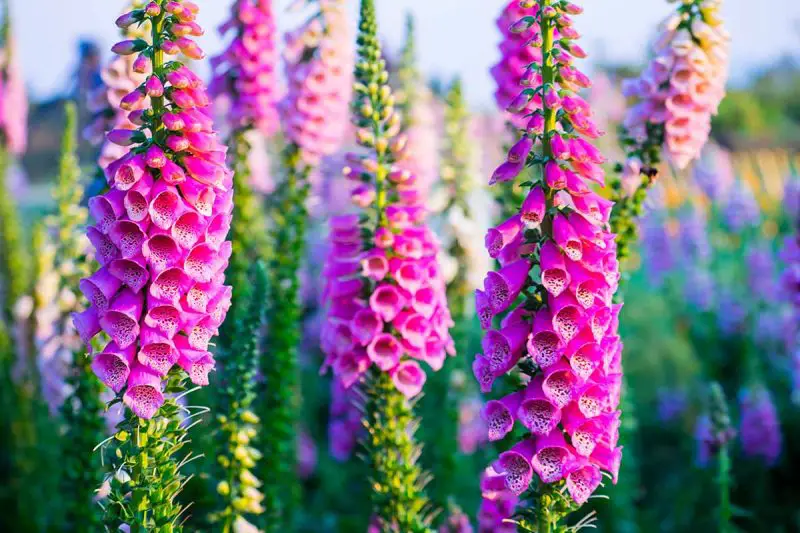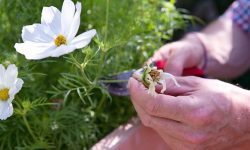Foxglove is a captivating flower that adds dramatic height and charm to any garden. Known for its tall spires filled with tubular blooms, it offers vibrant colors ranging from soft pastels to rich purples. These flowers not only create a striking display but also attract pollinators like bees and hummingbirds, making them valuable for both beauty and biodiversity.
Learning how to grow foxglove successfully ensures your garden thrives with healthy plants and long-lasting flowers. From seed starting to proper care, each step matters for robust growth. With the right conditions, foxglove can transform your landscape into a vibrant showcase of color. This guide will provide you with practical tips for growing and maintaining these enchanting blooms.
Light and Temperature
Light plays a crucial role in the development of young foxglove plants. While foxgloves can tolerate partial shade, young seedlings grow best with bright, indirect light. If grown indoors, placing them near a sunny window or under grow lights can provide the necessary energy for leaf development. Outdoors, choose a spot that receives morning sun and afternoon shade, which prevents scorching while still ensuring enough light for photosynthesis.
Temperature is equally important for foxglove seedlings. They thrive in cool to moderate conditions, ideally between 60°F and 70°F (15°C–21°C). Protecting them from extreme heat or cold is key during the early growth stage. Sudden temperature changes can slow their development and weaken the plants. If a cold snap is expected, consider covering them with a light frost cloth. Providing a stable environment with adequate light and favorable temperatures gives young foxgloves the best start for robust growth and future blooms.
Thinning and Transplanting
As foxglove seedlings begin to grow, they often become crowded, competing for light, nutrients, and space. Thinning is a crucial step to ensure that each plant develops into a strong, healthy specimen. When seedlings have reached a few inches tall, carefully thin them by snipping weaker ones at the soil line rather than pulling them up, which could disturb the roots of neighboring plants. Aim to leave about 12 to 18 inches of space between each plant, as foxgloves need room to expand and establish a strong root system. Proper thinning at this stage encourages sturdier growth and helps reduce the risk of disease caused by poor airflow.
Transplanting is another important stage, especially if you started your foxglove seeds indoors or in a nursery bed. Once seedlings are large enough to handle and the weather is mild, carefully move them into their permanent outdoor location. Choose a cool, partly shaded spot with rich, well-drained soil to minimize stress. When transplanting, handle seedlings gently, holding them by the leaves instead of the stems to avoid damage. Water thoroughly after planting to help roots settle in and recover from transplant shock. With proper thinning and transplanting, your young foxgloves will develop into strong, vibrant plants that will produce stunning flower spikes in the seasons to come.
Caring for Foxglove Throughout the Season
Spring Care
Spring marks the beginning of active growth for foxgloves, especially for those that have overwintered from the previous year. During this time, the plants need consistent moisture and nutrient support to develop strong root systems and healthy foliage. Applying a balanced, slow-release fertilizer in early spring can encourage lush green leaves, which are essential for supporting the tall flower spikes later in the season. Weeding regularly also helps young foxgloves avoid competition for water and nutrients.
As temperatures rise, it is important to provide adequate watering, particularly during dry spells, to maintain steady growth. Mulching around the base of the plants helps retain soil moisture and keeps the roots cool. Gardeners should also thin crowded seedlings or transplant them to ensure proper spacing, as good airflow reduces the risk of fungal diseases. With attentive care in spring, foxgloves will be well-prepared for their spectacular summer bloom.
Summer Care
Summer is the season when foxgloves showcase their tall spires of bell-shaped flowers. To support prolonged blooming, it is essential to water deeply and consistently, particularly during hot weather. Deadheading spent blooms encourages some varieties to produce side shoots and extend the flowering period. Adding a light application of liquid fertilizer every few weeks can boost flower production and keep the foliage looking healthy.
During this stage, pests like aphids and diseases such as powdery mildew may appear, so regular inspection and timely treatment are crucial. Providing partial shade during extremely hot days helps prevent stress and keeps the flowers vibrant for longer. If left to mature, some flowers will form seed pods, which can be harvested for future planting. By maintaining steady care in summer, foxgloves can deliver weeks of striking color in the garden.
Fall Care
In fall, foxglove plants naturally slow down after their blooming season. This is the time to focus on preparing them for the colder months ahead. Cutting back spent flower stalks to the base helps redirect energy into the roots, allowing the plant to strengthen itself for winter survival. If you want self-seeding, however, allow some flower stalks to remain until the pods release seeds into the soil.
As temperatures drop, applying a layer of organic mulch around the base provides insulation for the roots. This is especially important in colder climates where frost can damage the crown of the plant. Fall is also a suitable time to transplant young foxgloves that may have germinated earlier in the season. With careful fall maintenance, foxgloves will have a better chance of overwintering successfully and producing stronger growth in the following spring.
Winter Care
During winter, foxglove plants often remain dormant, particularly in regions with freezing conditions. Biennial varieties usually spend the first winter as rosettes of leaves close to the ground, storing energy for next year’s bloom. Protecting these rosettes is essential, and a thick layer of mulch or straw can shield them from frost damage. Avoid overwatering during this time, as cold, soggy soil can lead to root rot.
In mild winter climates, foxgloves may retain some green growth. Regular checks for pests hiding in the foliage can help prevent early spring infestations. Avoid heavy pruning in winter, as it may weaken the plant before it enters its growth cycle. By allowing the plant to rest undisturbed and providing necessary protection, gardeners ensure that foxgloves will re-emerge vigorously when the weather warms again.
Pest and Disease Management
Foxgloves, like many garden plants, are prone to certain pests and diseases that can weaken growth and reduce flowering. Common pests include aphids, slugs, and snails, which feed on young leaves and tender stems. These pests not only cause direct damage but can also spread diseases from one plant to another. Regularly inspecting your foxgloves and removing pests by hand or using organic deterrents, such as crushed eggshells or neem oil, can keep populations under control without harming beneficial insects.
Diseases such as powdery mildew, leaf spot, and crown rot can also affect foxgloves, particularly if the plants are grown in damp or overcrowded conditions. Ensuring proper air circulation around the plants is one of the most effective preventative measures. Watering at the base rather than on the leaves helps reduce fungal growth, while mulching can prevent soil-borne diseases from splashing onto foliage during rain. In cases of severe infection, removing and disposing of affected leaves is necessary to prevent spread.
Another important step in pest and disease management is crop rotation and avoiding planting foxgloves in the same spot every year. This helps reduce the buildup of soil-borne pathogens that can persist over time. Applying a balanced fertilizer can also strengthen the plant’s natural defenses, making it less susceptible to attacks. With consistent care and proactive measures, foxgloves can thrive with fewer setbacks and maintain their striking appearance throughout the growing season.
Staking and Supporting Tall Stems
Foxgloves are known for their tall, elegant flower spikes, which can sometimes reach impressive heights. While this vertical growth adds drama to the garden, it also makes the plants vulnerable to damage from strong winds, heavy rains, or even the weight of their own blossoms. Without proper support, tall stems may bend or snap, diminishing the overall beauty of the display. Staking helps prevent such problems and ensures the flowers remain upright and visible.
The best time to stake foxgloves is early in the growing season, before the flower spikes reach full height. Using bamboo canes, wooden stakes, or even decorative supports, position them close to the base of the plant and gently tie the stem with soft garden twine or plant ties. It is important not to tie the stems too tightly, as this can restrict growth and damage the plant. Instead, create a loose loop that holds the stem securely but still allows for natural movement.
In addition to individual staking, planting foxgloves in groups can provide mutual support, reducing the risk of collapse. Taller varieties or those in exposed garden areas may need more frequent attention to ensure they remain upright throughout the season. Regularly checking the ties and adjusting them as the plant grows helps prevent girdling or breakage. By giving foxgloves the right structural support, you allow their impressive spires to stand tall and enhance the vertical interest of the garden without interruption.
Companion Planting With Foxglove
Companion planting with foxglove is both an aesthetic and practical choice for gardeners. The tall spires of foxglove add vertical drama, while their ability to thrive in partial shade makes them versatile companions. They work beautifully when planted among lower-growing perennials, creating layers of color and texture. Pairing foxglove with hostas, ferns, or astilbes enhances the woodland garden look, making shady corners more vibrant.
From a functional perspective, foxglove can also help deter certain pests. Its toxic leaves discourage browsing from deer and rabbits, protecting nearby plants. When placed near roses, foxglove not only enhances beauty but also indirectly helps shield them from common garden nibblers. Additionally, foxglove blooms attract bees and hummingbirds, boosting pollination for other flowers nearby. This synergy makes it an excellent addition to pollinator-friendly gardens.
For striking contrasts, gardeners often combine foxglove with brightly colored blooms like delphiniums, columbines, or poppies. The tall spires provide a backdrop, while shorter companions fill in gaps at the base. This layered design ensures there are no bare spaces once foxglove finishes blooming. Whether planted in a cottage garden or a shaded border, foxglove enriches the planting scheme by balancing structure, color, and ecological benefits.
Landscaping Ideas With Foxglove
Foxglove is a showstopper in landscape design, thanks to its bold height and bell-shaped flowers. In cottage gardens, it is often planted along fences, walls, or the back of mixed borders where its towering spikes stand tall behind lower-growing plants. This layering technique creates depth and draws the eye upward, emphasizing the natural flow of the garden.
In woodland landscapes, foxglove thrives beneath tall trees or along shady paths, adding splashes of soft pastel color in otherwise green areas. It pairs well with ferns and hostas, providing a contrast between bold flower spikes and leafy textures. By planting in groups of three or more, gardeners can create natural-looking drifts that mimic wildflower meadows. These plantings look especially magical when viewed from a distance.
For a more modern approach, foxglove can also be used as a dramatic focal point in mixed containers or raised beds. Planted alongside ornamental grasses, it offers a striking contrast between the vertical lines of its blooms and the swaying textures of grass. Whether incorporated into traditional cottage gardens or contemporary designs, foxglove’s versatility allows it to complement a wide range of landscaping styles.
Safety Precautions With Foxglove
While foxglove is undeniably beautiful, it is also highly toxic and requires careful handling. All parts of the plant, including leaves, flowers, and seeds, contain cardiac glycosides that can be dangerous if ingested. For households with children or pets, foxglove should be planted in less accessible areas to reduce the risk of accidental contact or ingestion.
Gardeners should also take care when working with foxglove. Wearing gloves while pruning, deadheading, or handling spent flower stalks helps prevent skin irritation. Even though contact reactions are rare, the sap can sometimes cause mild discomfort. After gardening tasks, washing hands thoroughly is essential, especially before eating or touching the face.
It’s also wise to educate family members and visitors about the plant’s toxicity. While foxglove attracts pollinators safely, humans and pets must avoid chewing or tasting it. If included in a garden, clear labeling or placement in designated areas ensures its beauty can be admired safely. With proper precautions, foxglove remains a safe and stunning addition to the landscape, offering charm without compromising well-being.
FAQ About How to Grow Foxgloves
What plants grow well with foxglove in the garden?
Foxgloves pair beautifully with shade-loving plants such as hostas, ferns, and astilbes. They also complement roses, delphiniums, and lupines in cottage-style gardens. Companion planting with these species not only enhances visual appeal but also encourages pollinators, creating a balanced and thriving garden ecosystem.
How long do foxgloves usually bloom?
Foxgloves typically bloom from late spring through midsummer, lasting about three to four weeks. With proper care, including deadheading spent flowers, some varieties may produce secondary blooms. Ensuring consistent moisture, partial shade, and nutrient-rich soil extends their display and maintains their vibrant color throughout the growing season.
Are foxgloves safe to grow around pets and children?
No, foxgloves are toxic if ingested, containing compounds that affect the heart. This makes them unsafe for children and pets who might accidentally consume any part of the plant. It’s important to plant foxgloves in less accessible areas or use protective measures while educating family members about the potential risks.
How can I make foxgloves last longer in the garden?
To extend foxglove life, remove faded blooms promptly to encourage fresh growth. Mulching around the base retains soil moisture and reduces stress. Providing partial shade, adequate water, and periodic fertilization helps them thrive. Re-seeding or planting new seedlings each year ensures a continuous display of tall, colorful flower spikes.
Do foxgloves come back every year?
Most foxgloves are biennials, meaning they flower in their second year before dying back. However, some perennial varieties exist and return annually if properly cared for. Allowing foxgloves to self-seed ensures new plants appear each season, creating a natural cycle of renewal and ongoing floral beauty in the garden.
Conclusion
Foxgloves bring drama, elegance, and timeless charm to any garden, rewarding you with tall spires of color and beauty. With proper care, seasonal attention, and mindful planting, they can transform ordinary spaces into enchanting landscapes. Whether used in borders, cottage gardens, or as companion plants, foxgloves never fail to impress. Their ability to attract pollinators while adding vertical interest makes them a gardener’s treasure. Remembering safety precautions ensures both beauty and peace of mind. Grow foxgloves with care, and enjoy their lasting magic year after year.







